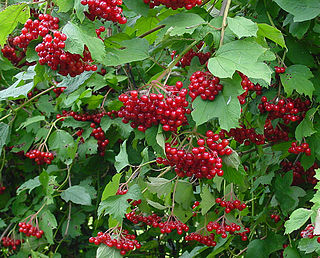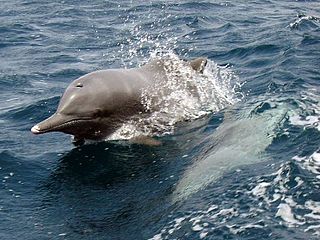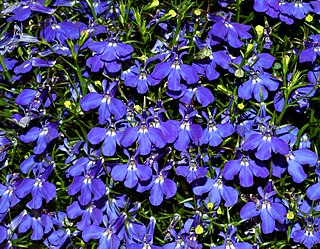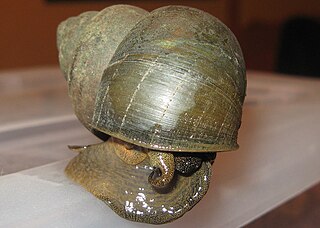
Lychee is a monotypic taxon and the sole member in the genus Litchi in the soapberry family, Sapindaceae.

Viburnum is a genus of about 150–175 species of flowering plants in the moschatel family, Adoxaceae. Its current classification is based on molecular phylogeny. It was previously included in the honeysuckle family Caprifoliaceae.

The Indo-Pacific humpback dolphin is a species of humpback dolphin inhabiting coastal waters of the eastern Indian and western Pacific Oceans. This species is often referred to as the Chinese white dolphin in mainland China, Macao, Hong Kong, Taiwan and Singapore as a common name. Some biologists regard the Indo-Pacific dolphin as a subspecies of the Indian Ocean humpback dolphin which ranges from East Africa to India. However, DNA testing studies have shown that the two are distinct species. A new species, the Australian humpback dolphin, was split off from S. chinensis and recognized as a distinct species in 2014. Nevertheless, there are still several unresolved issues in differentiation of the Indian Ocean-type and Indo-Pacific-type humpback dolphins.

Humpback dolphins are members of the genus Sousa. These dolphins are characterized by the conspicuous humps and elongated dorsal fins found on the backs of adults of the species. They are found close to shore along the coast of West Africa and right along the coast of the Indian Ocean from South Africa to Australia. Several institutions have made a proposal to divide the Indo-Pacific species into two distinct species: the Indo-Pacific humpback dolphin and the Australian humpback dolphin.

The Indian Ocean humpback dolphin is a member of the Delphinidae family occupying coastal areas ranging from Southern Africa to Western Indochina. The Indo-Pacific humpback dolphin was formerly included within the same species, but a 2014 study revealed them to be a separate species.

Lobelia is a genus of flowering plants comprising 415 species, with a subcosmopolitan distribution primarily in tropical to warm temperate regions of the world, a few species extending into cooler temperate regions. They are known generally as lobelias.

Glycyrrhiza is a genus of about 20 accepted species in the legume family (Fabaceae), with a subcosmopolitan distribution in Asia, Australia, Europe, and the Americas.
In theoretical physics, the Batalin–Vilkovisky (BV) formalism was developed as a method for determining the ghost structure for Lagrangian gauge theories, such as gravity and supergravity, whose corresponding Hamiltonian formulation has constraints not related to a Lie algebra. The BV formalism, based on an action that contains both fields and "antifields", can be thought of as a vast generalization of the original BRST formalism for pure Yang–Mills theory to an arbitrary Lagrangian gauge theory. Other names for the Batalin–Vilkovisky formalism are field-antifield formalism, Lagrangian BRST formalism, or BV–BRST formalism. It should not be confused with the Batalin–Fradkin–Vilkovisky (BFV) formalism, which is the Hamiltonian counterpart.

The genus Helwingia consists of shrubs or rarely small trees native to eastern Asia, the Himalayas, and northern Indochina. It is the only genus in the family Helwingiaceae.

Linnaea is a plant genus in the honeysuckle family Caprifoliaceae. Until 2013, the genus included a single species, Linnaea borealis. In 2013, on the basis of molecular phylogenetic evidence, the genus was expanded to include species formerly placed in Abelia, Diabelia, Dipelta, Kolkwitzia and Vesalea. However, this is rejected by the majority of subsequent scientific literature and flora.

Larix potaninii is a species of larch conifer in the family Pinaceae. It is found in China and Nepal. The one of southernmost species of the genus Larix, the range of Larix potaninii extends southward almost to 27° N.

The Chinese mystery snail, black snail, or trapdoor snail, is a large freshwater snail with gills and an operculum, an aquatic gastropod mollusk in the family Viviparidae. The Japanese variety of this species is black and usually a dark green, moss-like alga covers the shell.

Cipangopaludina is a genus of freshwater snails with a gill and an operculum, aquatic gastropod mollusks in the family Viviparidae.

Astilbe chinensis, commonly known as false goat's beard, tall false-buck's-beard or Chinese astilbe, is a plant in the saxifrage family, Saxifragaceae. It is a perennial herb that grows near shaded streams and rivers. It is also commonly grown in shade gardens.
The Chinese water snake, Chinese smooth water snake, Chinese mud snake or Chinese rice paddy snake is a species of mildly venomous, rear-fanged snake, endemic to Asia.

Iris domestica, commonly known as leopard lily, blackberry lily, and leopard flower, is an ornamental plant in the family Iridaceae. In 2005, based on molecular DNA sequence evidence, Belamcanda chinensis, the sole species in the genus Belamcanda, was transferred to the genus Iris and renamed Iris domestica.

Nardosinone is a sesquiterpene and chemical constituent of Nardostachys jatamansi. In in vitro studies, the compound has demonstrated concentration-dependent enhancement of bucladesine and staurosporine-induced neurite outgrowth. Nardosinone has similarly been demonstrated to enhance NGF-mediated neurite outgrowth and synaptogenesis from PC12D cells.

Callosobruchus chinensis is a common species of beetle found in the bean weevil subfamily, and is known to be a pest to many stored legumes. Although it is commonly known as the adzuki bean weevil it is in fact not a true weevil, belonging instead to the leaf beetle family, Chrysomelidae. Other common names include the pulse beetle, Chinese bruchid and cowpea bruchid. This species has a very similar lifestyle and habitat to Callosobruchus maculatus and their identities are often mistaken for each other. This beetle is a common pest targeting many different species of stored legumes and it is distributed across the tropical and subtropical regions of the world. C. chinensis is one of the most damaging crop pests to the stored legume industry due to their generalized legume diets and wide distribution.

Helwingia japonica, the Japanese helwingia, is a species of flowering plant the family Helwingiaceae. It is native to South-East Asia.

Stauntonia chinensis is a plant in the family Lardizabalaceae. It is endemic to China, where it is distributed in Yunnan, Guangxi, Guangdong, Zhejiang, Jiangxi, Fujian, Hunan, Anhui, Hong Kong, Guizhou and other places. It grows at an altitude of 500 meters to 1,300 meters above sea level and can be found in dense forests in mountainous areas, thickets on the hillside or sparse forests along the streams in valleys.


















